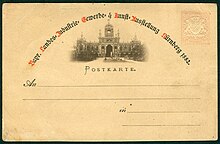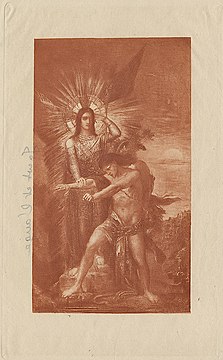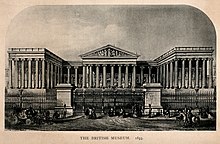

Collotype is a gelatin-based photographic printing process invented by Alphonse Poitevin in 1855 to print images in a wide variety of tones without the need for halftone screens. [1] [2] The majority of collotypes were produced between the 1870s and 1920s. [3] It was the first form of photolithography. [4]
Invention

Collotype originates from the Greek word kolla for (flour paste) glue. [5] Poitevin patented collotype printing the same year it was invented in 1855. The process was shown in 1859 by F. Joubert.
Process
Poitevin's Collotype
In Poitevin's process, a lithographic stone was coated with a light-sensitive gelatin solution and exposed through a photographic negative. [6] [7] The gelatin would harden in exposed areas, leading to the stone becoming hydrophobic in light areas (and thus receptive to the greasy ink) and hydrophilic under dark areas (ink-repelling). [5] [6] The stone was then printed via the standard lithographic process, producing a monochrome print.
1860s Developments
In 1865, Tessie du Motay and C. R. Marechal applied the gelatin to a copper plate, which was easier to handle than a lithographic stone. [5] However, the gelatin did not adhere well and limited print runs to about 100. [5]
In 1868, Joseph Albert and Jakub Husník applied a gelatin- albumen mixture to glass, which was then coated with light-sensitized gelatin. [5] This allowed print runs of up to 1,000. [5] This patent was later purchased by Edward Bierstadt, who developed one of the first commercial collotype companies in New York City. [8]

Later collotype
The collotype plate is made by coating a plate of glass or metal with a substrate composed of gelatin or other colloid and hardening it. Then it is coated with a thick coat of dichromated gelatin and dried carefully at a controlled temperature (a little over 50° Celsius) so it "reticulates" or breaks up into a finely grained pattern when washed later in approximately 16 °C water. The plate is then exposed in contact with the negative using an ultraviolet (UV) source which changes the ability of the exposed gelatin to absorb water later. The plate is developed by carefully washing out the dichromate salt and dried without heat. The plate is left in a cool dry place to cure for 24 hours before using it to print.
Related processes, or processes developed from collotype, or even alternate names for collotype include albertype, alethetype, autocopyist, artotype, gelatinotypy, heliotype, hydrotype, indotint, ink-photo, leimtype, lichtdruck, papryrotype, photogelatin, photophane, phototype, Roto-Collotype, Rye's, and Sinop. [9] [5] [10] [4]
Color collotype or chromocollotype
In 1874, Joseph Albert produced the first color collotypes with three collotype plates, each inked in a different color. [5] In 1882, the Hoeschtype, which used six plates, was patented. [5]

Combination processes

Mezzograph collotype
Mezzograph was a trade name used by Valentine Co. Ltd. of Scotland, for their multicolored postcards, printed in a hybrid process where colors were printed via photolithography and then overprinted in black or blue collotype for the "outlines" of the image. [5]
Halftone collotype
Halftone collotype processes combine halftone printing and collotype. These include the Jaffetype, developed in Vienna; the Aquatone, developed and patented by Robert John in the United States in 1922, in which the gelatin is not reticulated; [11] the Gelatone process, introduced in 1939; and the Optak process, introduced in 1946. [5]
Characteristics
Collotype was most often printed in monochrome in various colors of ink, most commonly black, brown, green, blue. [12] In double-rolled collotype, the plate was first inked with stiff black ink and then re-inked with a softer colored ink; only one impression was taken. [13] This process was most common in fancy postcards. [13]
Collotype has a finely reticulated pattern that captures the tonal shifts of photography with a much more subtle effect that other photographic printing processes of the late 19th century, such as halftone engraving. [4] Under magnification, the edges of the print appear as diffuse fine curved lines, unlike the more defined edges of relief or intaglio prints. [14]
Richard Benson has described the finnicky nature of collotype printing, primarily problems of registration with damp paper and the varied tones from sheet to sheet. [12] As a young printer during the 1960s, Benson recalled how superstitious the collotype printers were because of the delicacy of the process. [12]
As collotype is a hand-printed process, it can be printed on hand-made paper, which differentiates it from other forms of photographic reproduction. [15]
Historical use
The collotype printing process did not achieve commercial viability until Joseph Albert invented the first mechanized collotype press in 1868. Short runs can printed on a proofing press, but longer print runs are carried out on a flatbed machine, where the plate is made square, level and fixed on the bed. The plate is then dampened with a slightly acidic glycerine–water mixture which is selectively absorbed by the different gel hardnesses, blotted before inking with collotype ink using a leather nap or velvet rollers. Best results are achieved with hard finished paper such as Bristol, placed upon the plate and covered with a tympan before slight pressure is applied. The collotype process uses much less pressure than other types of printing, such as lithography, letterpress or intaglio. While it is possible to print by hand using a roller or brayer, the best consistency in pressure and even distribution of ink is most effectively achieved on a mechanized press.
The collotype printing process was used for volume mechanical printing before the introduction of simpler and cheaper offset lithography. It can produce results difficult to distinguish from metal-based photographic prints because of its microscopically fine reticulations which compose the image. Many old postcards are collotypes. Its possibilities for fine art photography were first employed in the United States by Alfred Stieglitz.
Because of its ability to print fine detail, it was also used for business cards and invitations with fine script lettering.
Famous collotype works

Eadward Muybridge's Animal Locomotion: an Electro-Photographic Investigation of Connective Phases of Animal Movements (1883–86, printed 1887) was printed in collotype from photographs transferred to gelatin. [16]
After collotype had fallen out of commercial use, artists began to experiment with the process. Pablo Picasso's 1920 artist's book Le Tricorne was printed in (black) collotype with applied pochoir color. [17] Surrealist Max Ernst printed the frottages in the portfolio Natural History (1926) in collotype. [16] [18] Marcel Duchamp's La Boîte-en-valise (Box in a Suitcase), produced in the 1930s and 1940s, combines the techniques of collotype and stencil to create its "copies." [19] [20] Gerhard Richter's Mao (1968) is a collotype portrait of Mao Zedong. [21]
Contemporary Use
Commercial
As of 1983, there were only two commercial collotype firms in the United States, [22] and as of 1997, there were no commercial collotype printers in the United States. [9] As of 2015, there were two commercial collotype printers in Kyoto, Japan. [23] In Europe, the firm Fratelli Alinari ( Florence) and Lichtdruck-Kunst ( Leipzig) still produce collotypes, primarily as high-quality art reproductions for museums. [24]
Non-Commercial or Artistic
In 2010, only a small number of facilities in the United States, primarily art studios or organizations, still have the ability to create collotypes. [5]
Gallery
Monochrome collotypes
-
Pretty Nose, collotype with black ink, 1879.
-
Collotype (on left page), 1887.
-
Collotype reproduction of original painting by Henry Sandham, 1896.
-
Collotype in black ink of a painting, 19th century.
-
Collotype with green ink, 1908.
-
Collotype in sepia ink, 1913.
-
Collotype in blue-grey ink.
Monochrome collotypes with applied color
-
Hand-colored collotype, 1896.
-
Collotype with handprinted color, 1900.
-
Edward Burne-Jones' The Flower Book (1905), collotype with applied pochoir.
-
Collotype (of an engraving) with applied watercolor, 1913.
-
Postcard of Biarritz, collotype print with applied color, ca. 1916.
-
Hand-colored collotype, ca. 1877–1920.
Multicolored collotypes
-
Collotype with brown and blue ink.
-
Lobby card of Mary Pickford, 1921.
-
Gazelle by Franz Marc, 1923: a collotype reproduction of a painting.
References
- ^ "The Poitevin Patents and the Importance of Using Primary Sources". BrevetsPhotographiques.fr. Archived from the original on 2013-02-13.
- ^ Jones, Bernard Edward. Cassell's cyclopaedia of photography. Ayer Publishing.
- ^ "Photographic processes". Victoria and Albert Museum. Archived from the original on 2019-07-21. Retrieved 2021-01-20.
- ^ a b c "Collotype". Society of American Archivists Dictionary. Society of American Archivists. Archived from the original on 2021-05-02. Retrieved 2021-11-12.
- ^ a b c d e f g h i j k l Stulik, Dusan C.; Kaplan, Art (2013). Collotype (PDF). The Atlas of Analytical Signatures of Photographic Processes. Los Angeles: The Getty Conservation Institute. ISBN 978-1-937433-07-9. Retrieved June 9, 2020.
- ^ a b "Collotype: printing process". Encyclopedia Britannica. Archived from the original on 2015-09-06. Retrieved 2021-01-19.
- ^ "Collotype". The Museum of Modern Art. Archived from the original on 2021-04-11. Retrieved 2021-11-12.
- ^ Tom Reardon and Kent Kirby, "Collotype: Prince of Printing Process." Printing History 25 (1991): 9.
- ^ a b Defibaugh, Denis (1997). The Collotype: & History, Process, Photographic Documentation [MA Thesis]. Rochester, NY: Rochester Institute of Technology.
- ^ Schnauss, Julius (1889). Collotype and Photo-lithography. Translated by Middleton, Edward C. London: Iliffe and Son (published September 3, 2015).
- ^ Tarr, John Charles (1949). Printing to-day. The Pageant of Progress, no. 17 (revised ed.). London: Oxford University Press. p. 109.
- ^ a b c Benson, Richard (2008). The printed picture. New York: Museum of Modern Art. p. 243. ISBN 978-0-87070-721-6. OCLC 438465528.
- ^ a b Benson, Richard (2008). The printed picture. New York: Museum of Modern Art. p. 252. ISBN 978-0-87070-721-6. OCLC 438465528.
- ^ Horsfall, Craig (2017-02-23). "Identifying collotypes". The Book & Paper Gathering. Archived from the original on 2017-02-24. Retrieved 2021-11-12.
- ^ Curwen, Harold (1934). Processes of graphic reproduction in printing. London: Faber and Faber. p. 123.
- ^ a b Kirby, Kent (1976). "The Collotype Printing Process: A Proposal for Its Revival". Leonardo. 9 (3): 183–186. doi: 10.2307/1573550. ISSN 0024-094X. JSTOR 1573550. S2CID 191386482.
- ^ "Pablo Picasso. Le Tricorne. 1920". The Museum of Modern Art. Archived from the original on 2017-11-03. Retrieved 2021-11-12.
- ^ "Max Ernst, Natural History (Histoire naturelle), c. 1925, published 1926". The Museum of Modern Art. Retrieved 2021-01-20.
- ^ "Box in a Valise". Peggy Guggenheim Collection. Retrieved 2023-01-25.
- ^ Judovitz, Dalia (2005). "Duchamp's "Luggage Physics": Art on the Move". Postmodern Culture. 905: 13 – via University of Virginia Library.
- ^ Weitman, Wendy (2004), "Gerhard Richter: Mao," in Deborah Wye, Artists and Prints: Masterworks from The Museum of Modern Art, New York: The Museum of Modern Art, 2004, p. 180.
- ^ Chayt, Steven; Chayt, Meryl (1983). Collotype: Being a History-Practium-Bibliography. Winter Haven, FL: Anachronic Editions. p. 2.
- ^ Zhang, Michael (May 26, 2015). "A Look at Benrido, One of the Last Collotype Printers in the World". Peta Pixel. Archived from the original on 2015-05-31. Retrieved 2021-01-20.
- ^ Thirkell, Paul; Hill, Victoria (2009). "The reproduction, conservation and creation of artwork through the Collotype Printing Process". In Colborne, J; Fisherman Snyder, R (eds.). Printed on Paper: The Techniques, History and Conservation of Printed Media. Newcastle: Northumbria University. pp. 165–9.
External sources
- Defibaugh, Denis (1997). The Collotype: & History, Process, Photographic Documentation [MA Thesis]. Rochester, NY: Rochester Institute of Technology.
- Dusan C. Stulik, Art Kaplan, Collotype. Getty Conservation Institute, 2013 (Atlas of Analytical Signatures of Photographic Processes)
- Video of collotype printing at Benrido Press, Kyoto, Japan (2009).
- http://collotype-vienna.com















